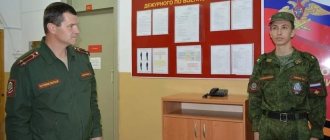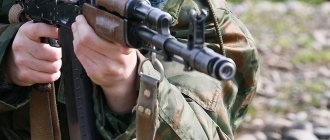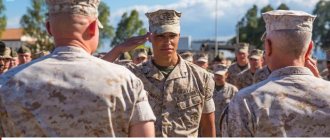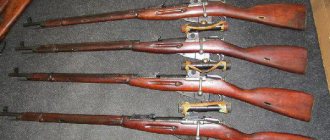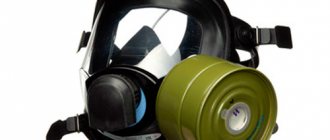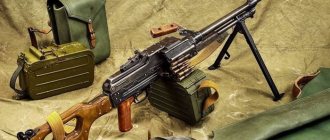What is a guard
A guard is a special armed unit that guards and defends military flags, military and government facilities , as well as citizens held in disciplinary battalions.
To directly protect objects, sentries are appointed from the general staff. A sentry is an armed guard who is obliged to carry out combat missions to protect a designated outpost.
A post is everything that is entrusted to the sentry, as well as the area of the area in which the sentry’s service is carried out.
The boundary of each post is determined by the commander , who organizes the security and defense of objects.
Security can be carried out both by patrolling between fences and by observation from special towers. Some objects may be guarded by stationary sentries.
Purpose and tasks of the guard service.
Organization of guard service
Carrying out guard duty is the fulfillment of a combat mission
and requires from the personnel strict compliance with all provisions of the Charter of the garrison and guard services, high vigilance, unwavering determination and initiative.
Those guilty of violating the requirements of the guard service bear disciplinary or criminal liability.
Guards are appointed to perform guard duty.
A guard is an armed unit assigned to carry out the combat mission of guarding and defending battle flags, military and government facilities, as well as to protect persons held in a guardhouse and in a disciplinary military unit.
There are garrison and internal (ship) guards; they can be permanent or temporary.
The garrison guard is assigned to protect objects of general garrison importance and objects of several military units located in close proximity to one another.
The internal (ship) guard is assigned to guard and defend the facilities of one military unit (ship). Airplanes (helicopters) and other objects of the aviation unit at the airfield are guarded and defended by an internal guard assigned from the aviation technical unit and support units (units).
The following are appointed to the guard:
- chief of the guard;
- guards according to the number of posts and shifts;
- guards, and, if necessary, assistant chief of guard;
— shift of operators for technical security equipment, the number of operators in a shift is determined depending on the importance of the protected object, the length of its perimeter, the number of installed video surveillance systems, but not less than three military personnel, one of whom can be appointed assistant chief of guard for technical security equipment;
- assistant chief of guard for the service of guard dogs and vehicle drivers (crews of combat vehicles).
In addition to the listed persons, checkpoint guards are assigned to the guards for the protection of headquarters and control points from the association and above, as well as for the protection of institutions, and exit guards are assigned to the guardhouse guards.
For the immediate protection and defense of objects, sentries are posted from among the guards.
Guard
- a serviceman from the guard assigned to perform the combat mission of protecting and defending an object (post).
Sentry
is called an armed guard who performs the combat mission of protecting and defending the post entrusted to him.
Posting
everything entrusted to the guard and defense is called, as well as the place or area of the terrain in which he performs his duties. The posts include objects protected by guards using technical security means, and areas of the area where these means are installed.
The guards guard the objects by patrolling along the sentry path along the inside of the outer fence (control strip) around the object, as well as by observation from the towers. Individual objects may be guarded by stationary sentries.
Fencing of objects and equipment of posts.
The territory in which the protected objects are located must have external and internal fences no less than 2 m high with a distance between the wire threads: in the lower part - no more than 5 cm, in the upper part - no more than 15 cm. The distance between the external and internal fences is determined depending on local conditions and can be 10 m or more. Between the fences there is a path (path) for the movement of sentries and a control strip adjacent to the outer side of the fence, at least 5 m wide.
For the convenience of monitoring the approaches to the protected object, observation towers (Fig. 2) with bulletproof fencing, equipped with communications, alarm systems, and lightning protection devices are installed between the fences (near the outer fence).
If necessary, by decisions of the Minister of Defense, as well as the first leaders of other troops and military formations, the parameters of observation towers may be changed.
At particularly important facilities, special engineering structures can be installed or armored vehicles with weapons and observation and aiming devices and engineering barriers (MZP, “spotykach”, gouges, trenches), observation towers with bulletproof fencing and anti-grenade nets, equipped with communications and signaling equipment, lightning protection, can be installed. devices.
On the approaches to the territory with protected objects, signs are installed that are clearly visible day and night with the inscription, for example: “Passage (passage) is prohibited (closed).”
A detour (detour) is indicated by an arrow.
Around objects located outside the territory of a military unit, in agreement with local government bodies, prohibited zones and areas are determined in accordance with the law. The boundaries of the prohibited zone (district) must be marked on the ground with clearly visible signs with inscriptions in the state and Russian languages: “Forbidden zone (district) - passage (passage) is prohibited (closed).”
The head of the garrison (commander of a military unit, head of a protected facility) is obliged to promptly notify the population of the nearest populated areas through local government bodies about the establishment of the boundaries of the restricted zone (district). The boundaries of prohibited zones (areas) should not include existing public roads, residential and service buildings, cultivated fields, etc.
In the territory of the post, depending on local conditions, the sentry must be provided with visibility and fire - at least 50 m, therefore the area around the post must be cleared of bushes, trees thinned out, lower branches cut off to a height of 2.5 m, grass mowed, holes filled, the bumps are leveled, unnecessary objects are removed. The forbidden border, which determines the distance closer to which unauthorized persons are prohibited from approaching the post, is indicated at various times during the day, at night and in conditions of poor visibility by signs with inscriptions in the state and Russian languages, for example: “Forbidden border. Stop, they're shooting."
.
On the territory of objects that have several posts, the boundaries of each post are indicated on the ground with signs, for example: “Border of post No. 2.”
Types of guards
Garrison guards are appointed to carry out the defense of objects:
- army, district and central subordination, which do not have their own security units;
- several military units that are located in close proximity to each other;
- persons who are kept in the garrison guardhouse.
Internal guards are assigned to defend the objects of a military unit: ship, aircraft, etc.
There are guards:
- permanent - provided for by the schedule;
- temporary - carried out without a schedule, by order of the head of the garrison to protect property at the time of loading/unloading, escorting cargo, as well as to protect temporarily stored and seized property.
Armament of a sentry on duty
The duties of a sentry according to the Charter include the presence of weapons while on duty. Moreover, this applies to both night and daytime sentries. The sentry on duty must have a weapon with an attached bayonet-knife (bayonet), while an assault rifle with a folding butt - without a bayonet-knife, a bayonet-knife - in a sheath on the waist belt. At internal posts and at the post near the Battle Banner, an assault rifle with a wooden butt should be in the “on the belt” position, an assault rifle with a folding butt should be in the “chest” position, a carbine should be “to the leg” (the bag with the loaded magazine (clips) should be buttoned), the pistol is in a buttoned holster on the waist belt.
Sentry on duty with a carbine
Requirements for carrying weapons depending on the time of day:
- The pistol is kept in a buttoned holster attached to the waist belt. An assault rifle with a folding stock is placed in the “chest” position. The carbine is placed against the leg.
- At night, the weapon is held in a position from which it is possible to fire from a standing position. The weapon itself must be loaded and ready to fire.
In case of natural disasters or emergencies, the sentry may hold a weapon behind his back.
Duties of the guard
When carrying out guard duty activities, it is necessary to:
- carry out incoming orders from superiors clearly and on time;
- carry out your duties conscientiously;
- constantly improve skills and knowledge;
- ensure the safety of entrusted property and objects;
- keep state secrets;
- observe discipline, internal regulations and rules;
- do not get distracted and do not let go of the weapon;
- do not give weapons to anyone, including management;
- report on the progress of service within the time limits established by the report card for this post;
- do not leave the post until it is replaced or removed, even if there is a threat to life and health;
- have a weapon and be ready to act at any moment;
- do not allow anyone except the chief of the guard or his assistant, as well as your guard, to approach the post at a distance closer than what is recorded in the report card;
- be familiar with and remember the schedule and time of movement of the guard vehicle;
- be able to use fire extinguishing agents if necessary;
- in the event of an obvious attack, use weapons without warning;
- in case of activation of technical security means or barking of a service dog, immediately report to the guardhouse.
Prohibited actions while on guard duty
During service, the sentry is prohibited from:
- eating and drinking;
- smoking;
- dream;
- any conversations other than addressing and answering questions to persons to whom the sentry is subordinate;
- transfer to third parties or acceptance of any items from them.
In addition to the above, it is prohibited to read, write, sit or lean against anything/anyone. It is also not allowed to answer questions from strangers or touch them. Communication can only take place with the head of the guard, his assistant or guard, as well as persons who arrived for inspection. Also, you cannot chamber a cartridge unless absolutely necessary.
Specific articles that you need to know by heart can be found and printed at the link - Duties of a Sentinel
Other provisions of the Charter, according to which the sentry cannot:
- release weapons from your hands and hand them over to anyone, including the guard’s superiors;
- leave a post until it is changed or removed;
- leaving a post without permission - the action is equivalent to a crime;
- allow anyone closer to the post than the distance specified in the post report card and indicated on the ground by signs of the forbidden border - the exceptions are the chief of the guard, the assistant chief of the guard, the escorting guard and the persons they are accompanying.
As a result, we can say that the sentry is prohibited from performing all actions that would distract him from performing his official duties or affect the quality of his service.
Main goals
The main tasks of the guard service include:
- work to ensure the readiness of the guard for combat operations at the time of duty;
- creating and maintaining conditions for restoring the guard if it is violated during combat operations;
- control over the territory of guard duty;
- maintaining a high level of discipline among departments;
- maintaining reliable communications with all units of the garrison;
- guarding the premises and territories of the garrison, maintaining order in them.
- rules of guard duty
- at the moment of taking up his post, the guard is obliged, in the presence of the chief or his assistant, to check the presence and proper operation of everything that should be taken under guard on the basis of the post card. To protect prisoners, it is necessary to check the serviceability of locks, bars and the number of prisoners who are in the cell.
Special rights of a sentry at his post and requirements for him
Upon taking up the post, the sentry becomes a completely inviolable person. He also has special rights:
- the legislation of the Russian Federation provides special protection for the rights and personal dignity of a sentry on duty;
- it is necessary to unquestioningly follow all the instructions and requirements of the sentry;
- the sentry is strictly subordinate to the chief of the guard, his assistant and the guard;
- the sentry has the right to use weapons, but only in those special situations and cases that are recorded in the Charter.
Actions in special situations
The duties of the sentry, according to the Charter, include the protection of the entrusted object. This also includes the use of weapons if necessary.
The sentry has the right to use weapons when:
- attack on one's own person;
- attack on a protected object;
If the sentry notices strangers approaching the post, he is obliged to stop them with one of the commands:
- Stop, back!;
- Stop, go around right/left.
In conditions of poor visibility, when from the distance indicated in the post report card it is impossible to identify those approaching the post or the forbidden border of the post, the sentry stops all persons by shouting “Stop, who is coming?” If there is no response and (or) the violator crosses the forbidden border of the post, the sentry warns him with the shout “Stop, I’ll shoot” and detains the violator. The sentry reports the arrest of the violator to the guardhouse, monitors his behavior and, without weakening his attention, continues to guard the post assigned to him.
If the intruder, after the warning “Stop, I’ll shoot,” continues to move, the sentry places a cartridge in the chamber and fires a warning shot upward. If the offender fails to comply with this warning or if he flees, the guard will use a weapon against him.
When the guard’s shout is answered: “The chief of the guard (assistant chief of the guard, guard) is coming,” the sentry orders: “Chief of the guard (assistant chief of the guard, guard), come to me, the rest are in place”; if necessary, the sentry requires that those approaching him illuminate his face.
Having made sure that the one who introduced himself is really the chief of the guard (the assistant chief of the guard, the guard), the guard allows him and all the arriving persons to come to him. If the one who identified himself as the guard chief (assistant guard chief) turns out to be unknown or those with him do not comply with the sentry’s demands to remain in place, the sentry warns the violators with the shout “Stop, I’ll shoot.” If the violators fail to comply with this requirement, the sentry uses a weapon against them.
213. If it is necessary to engage in hand-to-hand combat to protect himself or a protected object, the sentry must boldly use a bayonet-knife (bayonet) and a butt.
214. In the event of a fire at the guard post, the guard immediately reports this to the guardhouse and, without ceasing to monitor the protected object, takes measures to extinguish the fire. In the event of a fire in the technical territory of a protected facility or in a facility that has external and internal fences, as well as near the post, he reports this to the guardhouse, continuing to serve at the post.
215. In the event of a sudden illness (injury), the sentry calls the guard or the chief of the guard, continuing to serve. 216. In extreme, urgent cases or in the event of a malfunction of communication means, the sentry may call the head of the guard or the guard with a shot upward to the post.
Moral aspects of guard duty
The sentry must understand that full responsibility for the object entrusted to protection rests on his shoulders. Therefore, under no circumstances should he leave his post, violate the Charter or neglect his duties. Otherwise, the sentry faces a tribunal.
But in addition to the Charter, the sentry must also rely on his own common sense. There is always a risk of unforeseen or atypical circumstances and situations arising. Such things must be reported to superiors if they are truly important and pose a potential threat to the safety of the object entrusted with protection.




